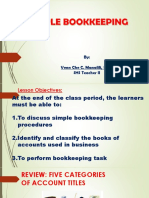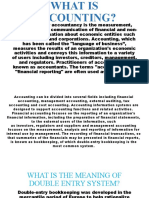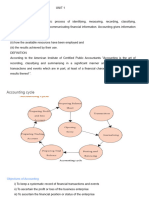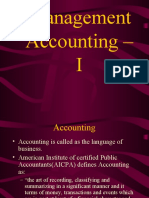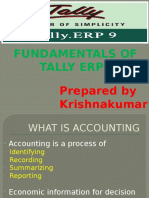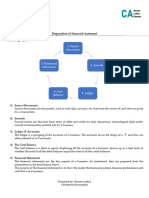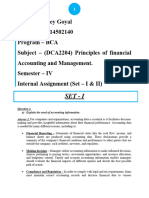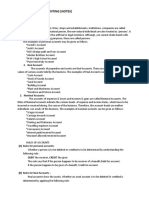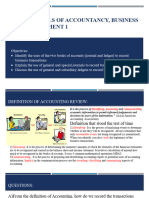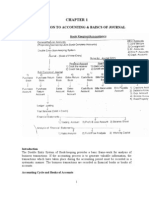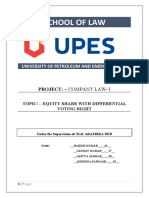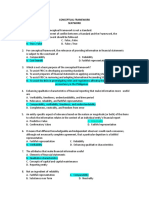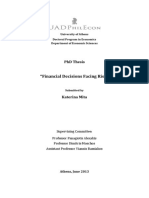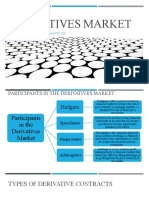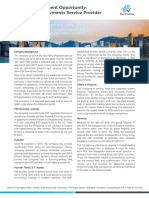AFM
AFM
Uploaded by
Ankita SainiCopyright:
Available Formats
AFM
AFM
Uploaded by
Ankita SainiOriginal Description:
Copyright
Available Formats
Share this document
Did you find this document useful?
Is this content inappropriate?
Copyright:
Available Formats
AFM
AFM
Uploaded by
Ankita SainiCopyright:
Available Formats
Accounting for Manager
Dr. N. N. Sengupta
Introduction to financial accounting
Accounting is a language of business.
As fundamental function of a
language is to serve as a means of
communicating the matters relating
to business operations.
Meaning and definitions
Accounting:
The American Institute of Certified Public Accounts
(AICPA) has defined accounting as the art of
recording, classifying and summarizing in a
scientific manner and in terms of money;
transactions and events which are in part at least
of a financial character and interpreting the results
thereof.
Features of Accounting
- Recording Journalizing
- Classifying Ledger
- Summarizing Trial Balance
- Interpreting Explaining the significance
of the financial statement
Need for Accounting
- Profit
- Future Planning
- Limited Memory
- To know the business positions
- To keep others informed
Objectives of Accounting:
- To make decisions
- To make systematic record of the
resources and obligations
- To ensure effective direction and control
- To ascertain financial positions of the
business
- To provide useful information to
interested parties
Branches of Accounting:
I Financial accounting
II Cost Accounting
III Management Accounting
Limitations of Accounting:
- Records only those transactions that can
be measured in money terms.
- It records transactions at cost. The
effects of change in prices are not shown
anywhere.
- Every chance of manipulation of
accounting profits by the accountant.
- It is only a post-mortem report.
Users of Accounting:
Uses of parties interested in accounting information
Internal users or parties External users or parties
- Owners of shareholders - Creditors
- Management - Government
- Employees - Consumer
- General public
- Other parties
a. Tax authorities
b. Stock Exchanges
c. Political Parties
d. Trade Union
Accounting Equations
Accounting equations means recording of
entries in a way that the assets equal
equities.
Assets = Equities
Equities = Owners Equity + Liabilities
Assets = Owners Equity + Liabilities
Type of Accounts
Type of Accounts
Personal Accounts Impersonal Accounts
Natural Artificial Representative Real Nominal
Account Account Account Account Account
Tangible Intangible
Account Account
Expense Incomes
Account Account
GOLDEN Rules :
Every business transaction has two aspects:
Rules of Account:
Personal Account: - Debit the receiver
- Credit the giver
Real Account: - Debit what comes in
- Credit what goes out
Nominal Account: - Debit all expenses and losses
- Credit all incomes and gains
Generally Accepted Accounting
Principles (GAAP):
Generally Accepted Accounting Principle (GAAP) are
concerned with the measurement of economic activity
recording, disclosing, preparation and presentation of
information in form of financial statements. They encompass
the conventions; rules and procedures necessary to define
accepted accounting principles at a particular time. They also
includes the broad guidelines of general application but also
detailed practices and procedures.
Sources of GAAP
The authentic and authoritative sources of GAAP are:
- American Institute of Certified Public Accounts (AICPA)
- Financial Accounting Standard Board (FASB)
- Government Accounting Standard Board (GASB)
- International Accounting Standard (IAS)
- Pronouncements of Securities and Exchange Commission (PSEC)
- Various Publications of Professional Organisations
- Various books, articles and Committee reports on accounting that
contain expressions of GAAP which are authentic.
ACCOUNTING PRINCIPLES
Classification
1. Accounting Concepts
2. Accounting Conventions
ACCOUNTING PRINCIPLES
Accounting Concepts
1. Business Entity Concepts
2.Going Concern
3. Dual Aspects Concepts
4.Accounting Period Concepts
5. Money Measurement Concepts
ACCOUNTING PRINCIPLES
Accounting Conventions
1. Convention of Conservatism
2. Convention of Consistency
3. Convention of Material Disclosure
Accounting Cycle
1.Analyze
Transactions
2.
Journalize
3. Post
4. Unadjusted
trial balance
5. Adjust
6. Adjusted
trial balance
7. Prepare
finance
statements
8.Close
Start the
next cycle
Numerical
Journalize the following transactions, post them in the Ledger
and balance the accounts on 31st January.
Ram started business with a capital of Rs. 10,000.
He purchased goods from Mohan on credit Rs. 2,000.
He paid cash to Mohan Rs. 1000.
He sold goods to Suresh Rs. 2000.
He received cash from Suresh Rs. 3000.
He further purchased goods from Mohan Rs. 2,000.
He paid cash to Mohan Rs. 1000.
He further sold goods to Suresh Rs. 2000.
He received cash from Suresh Rs. 1000.
Particulars L.F. Debit Amount
(Rs.)
Credit Amount
(Rs.)
Cash Account Dr.
To Capital Account
(Being commencement of business)
10000
10000
Purchase Account Dr.
To Mohan
(Being purchase of goods on credit)
2000
2000
Mohan Dr.
To Cash
(Being payment of cash to Mohan)
1000
1000
Suresh Dr.
To sales
(Being goods sold to Suresh)
2000
2000
Cash Account Dr.
To Suresh
(Being cash received from Suresh)
3000
3000
Purchase Account Dr.
To Mohan
(Being purchase of goods form Mohan)
2000
2000
Mohan Dr.
To Cash Account
(Being payment of Cash to Mohan)
1000
1000
Suresh Dr.
To Sales Account
(Being goods sold to Suresh)
2000
2000
Cash Account Dr.
To Suresh
(Being cash received from Suresh)
1000
1000
Total 24000 24000
Ledger
Cash Account
Dr. Cr.
Date Particulars Amount
(Rs.)
Date Particulars Amount
(Rs.)
To capital A/C 10000 By Mohan 1000
To suresh 3000 By Mohan 1000
To Suresh 1000 Jan.31 By Balance c/d 12000
14000 14000
Feb.1 To balance b/d 12000
CAPITAL ACCOUNT
Dr. Cr.
Date Particulars Amount
(Rs.)
Date
Particulars
Amount
(Rs.)
Jan
31
To Balance c/d
10000 By Cash A/c 10000
10000 10000
Feb 1 By Balance b/d
10000
PURCHASE ACCOUNT
Dr. Cr.
Date Particulars Amount
(Rs.)
Date Particulars Amount
(Rs.)
To Mohan
2000 Jan 31 By Balance c/d 4000
To Mohan 2000
4000 4000
Feb 1 To Balance b/d 4000
MOHAN
Dr. Cr.
Date Particulars Amount
(Rs.)
Date Particulars Amount
(Rs.)
To Cash 1000 By Purchases 2000
To Cash 1000 By Purchases 2000
To Balance c/d 2000
4000 4000
By Balance b/d 2000
SURESH
Dr. Cr.
Date Particulars Amount
(Rs.)
Date Particulars Amount
(Rs.)
To Sales 2000 By Cash 3000
To Sales 2000 By Cash 1000
4000 4000
Sales A/C
Dr. Cr.
Date Particulars Amount
(Rs.)
Date Particulars Amount
(Rs.)
Jan
31
To Balance c/d 4000
By Suresh 2000
By Suresh 2000
4000 4000
Feb. 1 By Balance b/d 4000
TRIAL BALANCE
as on 31st January
Particulars Debit (Rs.) Credit (Rs.)
Cash Account 12000
Capital Account 10000
Purchases Account 4000
Mohan 2000
Sales Account 4000
16000 16000
Thus, the two sides of the Trial Balance tally. It means
the books of accounts are arithmetically accurate.
Problem I
Journalize the following transactions and post them into the Ledger:
1999
Rs.
Jan 1 Surendra started business with cash 5000
Jan 2 Goods purchased from Prasad on credit
200
Jan 3 Goods sold to Prem 500
Jan 4 Goods purchased from Sohan for cash 400
Jan 5 Paid for wages 50
Jan 15 Goods purchased from Prem 100
Jan 17 Goods sold to Om 50
Jan 21 Goods purchase from Charanjit 300
Jan 23 Paid for interest 15
Jan 24 Goods purchased from Om 200
Jan 28 Cash received from Prem 100
Jan 31 Cash paid to Charanjit 300
Jan 31 Paid for Rent 10
Problem 2
On 1st January, 1999 the following were the ledger balances of Rajan & Co. Cash in hand Rs. 900; Cash
at bank Rs. 21,000; Soni (Cr.) Rs. 3000; Zahir (Dr.) Rs.2,400; Stock Rs. 12,000; Parsad (Cr.) Rs. 6,000;
Sharma (Dr.) Rs. 4,500; Lall (Cr.) Rs. 2,700; Ascertain capital.
Transactions during the month were:
1999
Rs.
Jan 2 Bought goods for Prasad 2700
Jan 3 Sold to Sharma 3000
Jan 5 Bought goods of Lall for cash, paid by cheque 3600
Jan 7 Took goods for personal use 200
Jan 13 Received from Zahir in full settlement 2350
Jan 17 Paid Soni in full settlement 2920
Jan 22 Paid cash for stationery 50
Jan 29 Paid to Prasad by cheque 2650
Discount allowed by him 50
Jan 30 Provided interest on capital 100
Rent due to landlord 200
Journalize the above transactions and post to the ledger and prepare a Trial Balance.
Accounting cycle involved the following stages:
1. Recording of Transactions: This is done in the book
termed as Journal.
2. Classifying the Transactions: This is done in the book
termed as Ledger.
3. Summarizing the Transactions: This includes
preparation of trial balance profit and loss account
and balance sheet of the business.
Accounting cycle involved the following
stages:
Interpreting the results: This involves
computation of various accounting ratios etc. to
know about the liquidity solvency and profitability
of business.
Journal
- Journal is defined as a book containing a
chronological record of transactions
- It is the book in which the transactions are recorded
first of all under the double entry system.
- This is a book of original record.
- The recording of transactions in journal is termed as
Journalizing
The Proforma of Journal
Date Particulars L.F. Debit
(Rs.)
Credit
(Rs.)
(1) (2) (3) (4) (5)
The Proforma of Journal
1. Date: The Date on which transaction was
entered is recorded here.
2. Particulars: The two aspects of transaction
are recorded in this column i.e. the
details regarding accounts which have to
be debited and credited.
The Proforma of Journal
3. L.F.: It means ledger folio. The
transactions entered in the journal are later
on posted to the ledger.
4. Debit: In this column, the amount to be
debited is entered.
5. Credit: In this column, the amount to be
credited is shown.
Compound Journal Entry
Sometimes there are a number of transactions
on the same date relating to one particular
account or of one particular nature. Such
transactions may be recorded by means of
single journal entry instead of passing several
journal entries.
It may be recorded in any of the following
three ways:
Compound Journal Entry
I A particular account may be debited while
several other accounts may be credited.
ii. One particular accounting may be credited
while several other accounting may be
debited.
iii. Several accounts may be debited and several
there accounts may be credit.
Ledger Position
- Ledger is a book which contains various
accounts.
- It may be also called ledger is a set of
account.
Ledger may be kept in any of the following
two forms
i. Bound Ledger
ii. Loose leaf ledger
Posting
The term Posting means transforming the
debit and credit items from the journal to
their respective accounts in the ledger.
Posting may be done at any time. However,
it should be completed before the financial
statements are prepared.
Posting
The Posting may be done by the book-keeper
from the journal to the ledger by any of the
following methods:
i. He may take a particular side first. For
example, he may take the debits first and
make the complete postings of all debits from
the Journal to the Ledger.
Posting
ii. He may take a particular account and post all
debits and credits relating to that account appearing
on one particular page of the Journal. He may then
take some other accounts and follow the same
procedure.
iii. He may complete postings of each journal entry
before proceeding to the next journal entry.
Relationship between Journal and Ledger
Both Journal and Ledger are the most
important books used under Double Entry
System of Book-keeping.
Journal is the book of first or original entry,
while the ledger is the book of second entry.
Relationship between Journal and Ledger
Journal Records Transactions is a
chronological order, while the ledger
records transactions is a analytical order.
Relationship between Journal and Ledger
Journal is more reliable as compared to the
ledger since it is the book in which the entry
is passed first of all.
The processing of recording transactions is
termed is journalizing while the process of
recording transactions is the ledger is called as
posting.
Rules Regarding Posting
The following rules should be observed while
posting transactions in the ledger from the
Journal:
i. Separate accounts should be opened in the
ledger for posting transactions related to
different accounts recorded in the
Journal.
Rules Regarding Posting
ii. The concerned account which has been
debited in the Journal should also be debited
in the ledger. However, a reference should
be made of the other accounts which has
been credited in the Journal.
Rules Regarding Posting
iii. The concerned account, which has been
credited in the Journal should also be credited in
the Ledger, but reference should be given of the
account, which has been debited in the
Journal
Use of the words To and By
It is customary to use words to and by
while making posting in the ledger.
The word to is used with the accounts
which appear on the debit side of a Ledger
Account.
Similarly, the word by is use with the
accounts which appear on the credit side
of the ledger account.
Cashbook
Cashbook is a special journal in which all cash
transactions are recorded directly. Cashbook
shows the cash receipts and the cash
payments. The Cashbook resembles a ledger
with the debit and credit sides, and the
balance represents cash on hand at the end of
the accounting period.
Kinds of Cashbook
Simple Cashbook/Single Column Cashbook
Double Column Cashbook
Three Column Cashbook
Simple Cashbook
In Simple Cashbook all the cash transactions are
recorded in chronological order. All cash receipts are
entered on the debit side and cash payments on the
credit side of the Cashbook. The difference between
the two sides is the cash in hand.
Simple Cashbook
Dr. CashBook Cr.
Date
Particulars L.F. Rs. Date Particulars L.F. Rs.
Double Column Cashbook
This Cashbook is an extension of simple Cashbook.
An additional column is maintained to record
discount involved in the settlement of debtors and
creditors in the double column Cashbook.
Double Column Cashbook
Dr. Cashbook Cr.
Date Particulars L.F. Discount
Rs.
Cash
Rs.
Date Particulars L.F. Discount
Rs.
Cash Rs.
Three Column Cashbook
The Three Column Cashbook is accounts for cash and
bank with additional information about discount
allowed and discount received.
Three Column Cashbook
Date Receipts Discount
allowed
Cash Bank Date Receipts Discount
allowed
Cash Bank
Dr. Cashbook
Cr.
Contra Entries
If a transaction affects both cash account and bank
account in the opposite sides, the entry for recording
the transaction is called a contra entry. Entries which
are made on both sides of the Cashbook are called
contra entries. No ledger posting is required,
because both aspects of the transaction are recorded
in the Cashbook itself. This fact I indicated in the
Cashbook by writing C in L.H. column.
Contra Entries
Date Particulars L.F Discount
Allowed
Cash Bank Date Particulars L.F Discount
Allowed
Cash Bank
Dr. Cashbook
Cr.
Petty Cashbook
The Petty Cashbook would contain a number of
analytical columns for grouping the various expenses
under a few classifications which would facilitate
subsequent posting into the General Ledger.
Analytical Petty Cashbook
Amount
Received
Date Particulars Total
Amount
paid
Postage and
Telegrams
Printing and
Stationery
Carriage Traveling
Expenses
Sundry
Expenses
Subsidiary Books
All non-cash transactions should be recorded in the
journal. The journal is inadequate as the single book
of the original entry when the transactions are
voluminous in number. The journal is divided into
divisions and they are commonly termed as
subsidiary books. Some of the subsidiary books are:
Subsidiary Books
Purchase Book
Purchase Returns Book
Sales Book
Sales Return Book
Bill Receivable Book
Bills Payable Book
Journal Proper
Purchase Book
Also known as the Purchases Journal, this book is used to record
credit purchases of goods only.
Purchase Book
Date
Particulars
(Name of Supplier, etc.)
L.F. Inward Invoice No. Amount
Rs.
Purchases Returns Book
This subsidiary book is used to record the goods purchased on credit
and sent back to suppliers as not conforming to specifications or for
any other reason.
Purchases Returns Book
Date Name of Supplier L.F. Debit Note No. Amount
Rs.
Sales Book
Also known as the Sales Journal, this subsidiary book is used to
record the sale of goods on credit.
Sales Book
Date Name of Customer L.F. Outward Invoice No. Amount
Rs.
Sales Returns Book
This book is used to record the transactions relating to goods sold on
credit and received back from the customers as not conforming to
the specifications or for any other reason.
Sales Returns Book
Date Name of Customer L.F. Credit Note No. Amount
Rs.
Bills Receivable Book
The Bills Receivable of an enterprise consists of all Promissory Notes
given or Bills or Exchange accepted by customers in respect of
amounts due from them.
Bills Receivable Book
S.No. Date From Whom
Received
Acceptor Date
of Bill
Term Date of
Maturity
L.F. Where
Payable
Amount
Rs.
How
Disposed
Trial Balance
Trial Balance is a statement containing the various
ledger balances on a particular date.
Proforma of Trial Balance
Trial Balance
As on 31
st
January in(Rs.)
Particular Debit Credit
(1) (2) (3)
Trial Balance
1. Under this head we take the ledger account
in which the balance is brought down either
on debit or credit side.
2. it is the amount in debit side of particular ledger
account.
3. It is the amount is credit side of a particular
ledger account.
Objective of Preparing a Trial
Balance:
- Checking of the arithmetical accuracy of the
accounting entries.
- Basis for financial statements
- Summarized ledger
Methods of Preparing Trial Balance:
i. Total Method: In case of this method the totals of
debit and credit of the accounts are shown in the
Trial Balance.
ii. Balance Method: In case of this method, the
balance of the ledger accounts are shown in the
respective debit and credit column of the trial
balance.
The total of the balance of the debit column must
be equal to the total balance of credit column.
Trial Balance and Adjustments
Before an accountant can proceed to prepare the
financial statements from the trial balance, he has to
process some additional information, which he
either already knows or receives from some other
divisions or departments. The following are a few
examples showing where adjustment entries would
be required:
Final Account
Final Account is prepared by the companies
To know the status of business and fulfill the
statutory obligation
The Final Account consists of two parts:
Income Statement or Trading and Profit and Loss
Account
Balance Sheet or Position Statement
Objective
Final Account is prepared to achieve these objectives
of business:
To know the profit he has earned or the loss he has
incurred for the period
And interested to know the financial position of the
business on a particular date.
The items are taken from trial balance
To know the profit he has earned or the loss he has incurred
for the period
And interested to know the financial position of the business
on a particular date.
Classification in Expenses and Income
Expenses and income are classified into capital and
revenue
Expenditure
Expenditure is an amount spend or incurred either once or
regularly
Capital Expenditure
It is an expenditure which is incurred for the
purpose of acquiring a fixed asset which increases
the earning. Capacity of the business over a long
period of time.
Revenue Expenditure
It is an expenditure which is incurred to meet the
day-to-day expenses of the business.
Receipts of Income
Receipts or income is an amount earned either once
or regularly
Capital Receipts
Capital Receipts are those receipts which are
received by a business once in a lifetime of the
business or after a long period of time.
Revenue Receipts
Revenue Receipts are those receipts which are
received frequent by a business.
Deferred Revenue Expenditure
Deferred Revenue Expenditure is a revenue
expenditure but the benefit of this expenditure does
not get exhausted in the same year but is available in
future period as well.
Deferred Revenue Expenditure:
It is written off over a number of years during which
its benefit is available and hence. It will be shown in
the Balance Sheet till its benefit is available.
Trading Account
Trading Account is the first stage in the final account.
The business concerns which are engaged is the
resale of goods after purchasing, prepare the trading
account. But the firms which manufacturing the
goods meant for sales prepare manufacturing
account.
Trading Account
Trading Account is prepared to ascertain the trading
results of the business i.e. gross profit earned a gross
loss suffered during the accounting period.
Performa of the Trading Account
Trading Accounting for the year ending (in Rs.)
Debit (Dr.)
Credit (Cr.)
Rs.
Rs.
Opening stock xxx Sales less returns xxx
Purchases less return xxx Closing stock xxx
Direct expenses xxx Gross Loss C/D xxx
Carriage inwards xxx
Wages xxx
Fuel and power xxx
Coal gas and water xxx
Octroi xxx
Import duty xxx
Custom duty xxx
Consumable stores* xxx
Salary of foreman / works manager xxx
Royalty on manufactured goods xxx
Gross Profit C/D xxx
xxx xxx
Consumable Store:
Opening balance of stores xxx
Add: Purchases of stores during the year xxx
xxx -
Less: Closing balance of stores xxx
- Consumables during the year xxx
Profit and Loss Account
Trading account shows only gross profit or gross loss
Next step is to prepare Profit and Loss Account which show
the net result of business in the form of net profit or net loss
for a particular period.
All the indirect incomes and indirect expenses are taken to
this account.
Indirect Expenses are classified:
Officer administrative expenses
Financial expenses
Selling and distribution expenses
Indirect Income are classified:
Rent received
Discount earned
Interest earned
Commission received
Bad debt recovered
Interest on securities
Tax refund
The Format of Profit and Loss Account is as follows:
Profit and Loss Account for the year ended:
Debit (Dr.)
Credit (Cr.)
Rs.
Rs.
Gross Loss b/d xxx Gross Profit b/d
xxx
Salaries xxx Rent received
xxx
Rent, Rates and Taxes xxx Discount received
xxx
Postage and Telegram xxx Commission received
xxx
Printing and Stationery xxx Interest received
xxx
Legal charges xxx Dividend and shares
xxx
Insurance xxx Interest and debentures
xxx
Audit fees xxx Profit on sales of assets
xxx
General expenses xxx Net loss
xxx
Depreciation xxx
Repair and Maintenance xxx
Advertisement xxx
Packaging charges xxx
Salesmen salaries xxx
Discount allowed xxx
Bad debts xxx
Delivery van expenses xxx
Traveling expenses xxx
Samples distributed xxx
Bank charges xxx
Interest on loans xxx
Fines and penalties xxx
Bills discounted xxx
Loss on sales of assets xxx
Loss by fire xxx
Net profit xxx
xxx
xxx
Balance Sheet
The next step in the final account is to be known the
financial status of a business on a particular date,
with the help of the statement that reveals assets
and liabilities, such statement is called Balance
Sheet.
Balance Sheet
In balance sheet assets are shown in right hand side
and liabilities in the left hand side
The accounting equation of balance sheet is:
Assets = Liabilities + Owners Equity
Marshalling of Balance Sheet
It may be done on two basis:
On the basis of liquidity.
it may be prepared on the basis of solvency.
Format of Balance Sheet in order of Liquidity
Balance Sheet as on -------
Liabilities Rs. Assets Rs.
Current liabilities xxx Current assets xxx
Sundry creditors xxx Cash in hand xxx
Bills payable xxx Cash at bank xxx
Bank overdraft xxx Closing stock xxx
Outstanding expenses xxx Sundry debtors xxx
Income received xxx Bills receivable xxx
In advance xxx Prepaid expenses xxx
Long term loans xxx Outstanding income xxx
Proprietors capital xxx Investments xxx
Fixed assets xxx
Furniture and fittings xxx
Plant and machinery xxx
Land and building xxx
Vehicles xxx
Goodwill xxx
xxx xxx
Balance Sheet in the order of solvency:
Balance Sheet as at:
Liabilities
Rs. Assets Rs.
Long term liabilities Fixed assets
Capital xxx Furniture and fittings xxx
Reserves and surplus xxx Plant and machinery xxx
Loans and advances xxx Land and building xxx
Current Liabilities Vehicles xxx
Sundry creditors xxx Goodwill xxx
Bills payable xxx Current assets
Bank overdraft xxx Cash in hand xxx
Outstanding expenses xxx Cash at bank xxx
Income received in advance xxx Closing stock xxx
Short term loans Xxx Sundry debtors xxx
Bills receivable xxx
Prepaid expenses xxx
Outstanding income xxx
Investments xxx
xxx
xxx xxx
Difference between the Profit and Loss Account
and the Balance Sheet:
Profit and loss account shows the net results of the business
in the form of net profit or net loss. On the other hand a
balance sheet depicts the financial positions of the business in
the form of its assets and liabilities.
Difference between the Profit and Loss Account
and the Balance Sheet
The profit and loss account is completed in
one accounting year whereas the balance
sheet is prepared as on the last day of the
financial year.
Difference between the Profit and Loss Account
and the Balance Sheet
The items shown in the profit and loss account
ceases in that year, while the items shown in
the balance sheet will continue as opening
balance the next accounting year.
From the following balance extracted from the books of M/s Rajendra Kumar Gupta & Co., pass the
necessary closing entries; prepare a Trading and Profit and Loss Account and a Balance Sheet.
The value of stock on 31
st
December, 2012 was Rs. 3700.
Particulars Rs Particulars Rs
Opening stock 1250 Plant and Machinery 6230
Sales 11800 Returns Outwards 1380
Depreciation 667 Cash in hand 895
Commission (Cr.) 211 Salaries 750
Insurance 380 Debtors 1905
Carriage inwards 300 Discount (Dr.) 328
Furniture 670 Bills Receivable 2730
Printing Charges 481 Wages 1589
Carriage Outwards 200 Returns Inwards 1659
Capital 9228 Bank Overdraft 4000
Creditors 1780 Purchases 8679
Bills Payable 541 Petty cash in Hand 47
Bad Debts 180
Trading and Profit & Loss Account
For the year ending 31
st
December, 2012
Particulars Amount Rs Particulars Amount Rs
To Opening Stock 1250 By Sales 11800
To Purchases 8679 Less: Returns 10141
Less: Returns Outward 1380 7299 Inwards 1659
To Wages 1589 Closing Stock 3700
To Carriage Inward 300
To Gross Profit c/d 3403
13841 13841
To Depreciation 667 By Gross Profit b/d 3403
To Insurance 380 By Commission 211
To Printing Charges 481
To Carriage Outwards 200
To Salaries 750
To Discount 328
To Bad Debts 180
To Net Profit 628
3614 3614
Balance Sheet
as on 31
st
December, 2012
Liabilities Amount
Rs
Assets Amount
Rs
Bills Payable 541 Cash 895
Creditors 1780 Petty Cash 47
Bank Overdraft 4000 Bills Receivable 2730
Capital
9228
Debtors 1905
Add: Net Profit
628
9856 Closing Stock 3700
Plant and Machinery 6230
Furniture 670
16177 16177
Numerical
Illustration 1: From the following Trial Balance
prepare the Manufacturing Account, Trading
and Profit and Loss Account for the year
ending 31st March, 1999 and the Balance
Sheet as on that date:
PARTICULARS DEBIT RS. CREDIT RS.
Shri Bankers Capital Account 41000
Shri Bankers Drawing Account 6100
Mrs. Bankers Loan Account 4000
Sundry Creditors 45000
Cash in Hand 250
Cash at Bank
4000
Sundry Debtors 40500
Patents 2000
Plant and Machinery 20000
Land and Buildings 26000
Purchases of Raw Materials 35000
Raw Material as on 1.4.1998 3500
Work in process as on 1.4.1998 2000
Finished Stock as on 1.4.1998 18000
Carriage Inwards 1100
Wages 27000
Salary of Works Manager
5600
Factory Expenses 3400
Factory Rent and Taxes
2500
Royalties (paid on sales)
1200
Sales (less Returns)
123400
Advertising
3000
Office Rent and Insurance
4800
Printing and Stationery
1000
Office Expenses
5800
Carriage Outwards
600
Discounts
1400 2100
Bad Debts
750
215500 215500
The Stock on 31st March, 1999 was as follows:
Rs. 4000 Raw Materials, Rs. 4500 Work-in-
progress and Rs. 28000 Finished Goods.
Solution
Manufacturing Account
For the year ending March 31, 1999
Particulars Rs.
Particulars Rs.
To Opening Work-in-process 2000 By Transfer to Trading
Account (Cost of finished
goods produced)
71600
To Raw Materials Used:
Opening Stock =3500
Add: Purchases= 35000
38500
Less: Closing Stock=4000
34500 By Closing Work in Process 4500
To Carriage Inwards 1100
To Wages 27000
To Salary of Works Manger 5600
To Factory Expenses 3400
To Factory Rent and Taxes 2500
76100
76100
Trading and Profit and Loss Account
For the year ending March 31, 1999
Particulars Rs.
Particulars Rs.
To Opening Stock of
Finished Goods
18000
By Sales
123400
To Manufacturing A/c (cost
of goods produced)
71600 By Closing Stock of Finished
Goods
28000
To Gross Profit c/d
61800
151400 151400
To Royalties 1200 By Gross Profit b/d 61800
To Advertising
3000 By Discount Received
2100
To Office Rent and Insurance 4800
To Printing and Stationery 1000
To Office Expenses 5800
To Carriage Outwards 600
To Bad Debts 750
To Discount Allowed 1400
To Net Profit Carried to
Capital Account
45350
63900 63900
Balance Sheet
As on 31st March, 1999
Liabilities Amount
(Rs.)
Assets Amount
(Rs.)
Current Assets:
Sundry Creditors 45000 Cash in Hand 250
Mrs. Bankers Loan 4000 Cash at Bank 4000
Capital Account
Balance Account Balance
on 1.4.1998 41000
Profit 45350
86350
Less: Drawings 6100
80250
Closing Stock:
Raw Materials 4000
Work in Process 4500
Finished Goods 28000
36500
Sundry Debtors
40500
FixedAssets:
Patents 2000
Plant and Machinery 20000
Land and Buildings 26000
129250 129250
Illustration 2
The following is the Trial Balance of Shri Om,
as on 31st March, 1999. You are requested to
prepare the Trading and Profit and Loss
Account for the year ended 31st March, 1999
and Balance Sheet as on that date after
making the necessary adjustments:
PARTICULARS DEBIT RS. CREDIT RS.
Sundry Debtors 500000
Sundry Creditors 200000
Outstanding Liability for Expenses 55000
Wages
100000
Carriage Outwards 110000
Carriage Inwards 50000
General Expenses
70000
Cash Discounts 20000
Bad Debts 10000
Motor Car 240000
Printing and Stationery 15000
Furniture and Fittings 110000
Advertisement
85000
Insurance 45000
Salesmans Commission 87500
Postage and Telephone
57500
Salaries 160000
Rates and Taxes
25000
Drawings 20000
Capital Account 1443000
Purchases 1550000
Sales 1987500
Stock on 1.4.99
250000
Cash at Bank 60000
Cash in Hand 10500
3630500 3630500
The following adjustments are to be made:
1 Stock on 31st March, 1999 was valued at Rs. 7,25,000.
2 A Provision for Bad and Doubtful Debts is to be created to the extent of 5
per cent on Sundry Debtors.
3 Depreciate:
Furniture and fittings by 10%
Motor car by 20%
4 Shri Om had withdrawn goods worth Rs. 25000 during the year.
5 Sales include goods worth Rs. 75000 sent out to Shanti and Co. on
approval and remaining unsold on 31st March, 1999. The cost of the goods
was Rs. 50000.
6 The salesmen are entitled to a Commission of 5% on total sales.
7 Debtors include Rs. 25,000 bad debts.
8 Printing and Stationery expenses of Rs. 55,000 relating to 1997-98 had not
been provided in that year but were paid in this year by debiting
outstanding liabilities.
9 Purchases include purchase of Furniture worth Rs. 50000.
Shri Om
Trading and Profit and Loss Account
For the year ended 31st March, 1999
Particulars Rs. Particulars
Rs.
To Opening Stock 250000
By Sales 1987500
Less; Goods sent on
Approval 75000
1912500
To Purchases: 1550000
Less:Drawings 25000
1525000
Less: Furniture 50000
1475000 By Closing Stock 725000
Add: stock on approval
(at cost) 50000
775000
To Wages
100000
To Carriage Inwards 50000
To Gross Profit c/d 812500
2687500 2687500
To Salaries
160000 By Gross Profit b/d 812500
To Rates and Taxes
25000
To Postage and Telephone 57500
To Insurance 45000
To Printing and Stationery 15000
To General Expenses 70000
To Depreciation:
Furniture (11000 + 5000)
Motor Car
16000
48000
To Salesmens Commission
(5% on Rs. 1912500)
95625
To Advertisement
85000
To Carriage Outwards 110000
To Bad Debts 10000
Add: Addl.Bad Debt 25000
Add: Prov. For Bad debts
(5% on Rs. 400000 20000
See W. N. 3)
55000
To Cash Discount 20000
To Net Profit
103758
812500 812500
Shri Om
Balance Sheet
As on 31.3.1991
Liabilities
Amount
(Rs.)
Assets
Amount
(Rs.)
Capital as on 1.4.98 1443000
Add: Net Profit 10375
1453375
Less: Drawings
(20000 +25000) 45000
1408375
Less: Printing & Stationery of last
year 55000
1353375
Furniture & Fittings 110000
Additions during the yr
50000
160000
Less: Depn. 16000
144000
Sundry Creditors 200000
Motor Car 240000
Less Depn. 48000
192000
Salesmens Commission
Outstanding (Rs. 95625
Rs. 87530)
8125 Closing Stock (725000 +
50000)
775000
Sundry Debtors 500000
Less:Goods sent on
Approval 75000
425000
Less: Addl. Bad Debts
25000
400000
Less: Provision for doubtful
debts 5% on 400000
20000
380000
Cash at Bank 60000
Cash in Hand 10500
1561500 1561500
Working Notes:
1 Both Sales and Sundry Debtors have been reduced by Rs.
75,000 representing invoice value of goods sent on approval.
Rs. 50000 have been added to the closing stock being the cost
of goods sent on approval.
2 Last years short provision for Printing and Stationery has not
been charged to the current years Profit and Loss Account. It
is preferable to charge it directly to in Capital Account.
3 Sundry Debtors = Rs. 500000 (Rs. 75000 Goods on Approval
+ Rs. 25000 Bad Debt) = Rs. 400000.
Problem I:
From the following particulars, prepare Manufacturing Account,
TradingAccount, and Profit and Loss Account:
Rs.
Purchase of Raw Materials 13195
Return Inward 70
Stock on 31.12.1998:
Raw Materials 1210
Work in Progress 1000
Finished Goods 1370
Productive Wages 2000
Factory Expenses 1840
General Office Expenses 300
Salaries 600
Distribution Expenses 100
Selling Expenses 700
Purchasing Expenses 600
Export Duty 300
Import Duty 200
Interest on Bank Loan 600
Stock on 1.1.1998
Raw Materials 400
Work in Progress 300
Finished Goods 410
Sales 19500
Return Outward 85
Carriage Outward 105
Carriage Inward 100
Cash Discount 10
Sale of Scrap 20
Depreciation of Machinery 500
Repairs of Machinery 100
Depreciation of Office Furniture 40
(Ans.: Gross Profit: Rs. 3470, Net Profit = Rs. 7150)
Problem 2 : From the following balances draw up a Trading and Profit and Loss
Account and Balance Sheet:
Particulars Amount (Rs.)
P. Parikh Capital 2000
Bank Overdraft 5000
Machinery
13400
Cash in Hand 1000
Fixtures and Fittings 5500
Opening Stock
45000
Bills Payable
7000
Creditors
40000
Debtors 63000
Bills Receivables 5000
Purchases 50000
Sales 129000
Return from Customers 1000
Returns to Creditors 1100
Salaries 9000
Manufacturing Wages
4000
Commission and T.A. 5500
Trade Expenses
1500
Discount (Cr.) 4000
Rent 2200
The Closing Stock amounted to Rs. 52000.
(Ans.: Gross Profit Rs. 82100; Net Profit Rs. 67900
a and Balance Sheet Total Rs. 1,39,900)
Meaning Of Cost
Institute of Cost and Work
Accountants, London defines Cost
as -:
The amount of expenditure incurred
on or attributable to a given thing
Meaning of Costing
Costing is classification and appropriate
allocation of expenditure for the
determination of the cost of products and
services and for the presentation of suitably
arranged data for the purpose of control and
guidance of the management.
Meaning of Cost Accounting
According to I.C.M.A, London -:
The process of accounting for the cost from the
point of which expenditure is incurred or
committed to the establishment of its
ultimate relationship with cost centers and
cost units.
Objectives and Functions of Cost
Accounting
Analysis and ascertainment of costs
Presentation of costs for cost reductions and cost
control
Planning and Decision making
Ascertain the profitability of the activities
Importance of Cost Accounting
Provides aid to management
Helps in compensating the employees in a
better way
Provides useful information to creditors,
investors and bankers
Benefits to the government and society
Limitations of Cost
Accounting
Not independent of
Systems of accounts
scope of subjectivity on items
Like depreciation
Based largely
On estimates
Considerations of all items of
Expenses and incomes
Are not taken
Meaning of Management Accounting
According to Anglo-American Council of
Productivity -:
It is the presentation of accounting
information in such a way as to assist
management in the creation of policy and the
day to day operation of the undertaking.
Comparison between Management
Accounting and Financial Accounting
Financial Accounting
Objective
To maintain account to
determine financial
position of business
Nature
It deals with historical
data.
Management Accounting
Objective
To help management to
formulate policies and
plan
Nature
It deals with projection of
data for the future.
Continues.
Subject matter
F.A assess the result of the
whole business
Compulsion
Preparation of F.A is
compulsory by law
Precision
It records the exact figures
of the transctions
Subject matter
M.A deals separately with
different units,
deptts.etc.
Compulsion
Preparation of M.A is not
necessary by law
Precision
It considers approximate
figures
Cost and Management Accounting
Cost Accounting
1. It records the
quantitative aspect of a
transaction
2. It records the cost of
producing a product and
providing a service
3. It only deals with cost
ascertainment
Management Accounting
1. it records both qualitative
and quantitative aspect
2. Provides information to
management for planning
and co-ordination
3. It is wider in scope as it
includes F.A, budgeting,
Tax, Planning.
Continue..
Cost Accounting
4. It uses both past and
present figures
5. Its development is
related to industrial
revolution
6. It follows certain
principles and
procedures for
recording costs of
different products
Management Accounting
4. It is concerned with the
projection of figures for
future.
5. It develops in accordance
to the modern business
world
6. It does not follow any
specific rules and
regulations.
ANALYSIS & CLASSIFICATION OF
COST
ACCODING TO HERALD J. WHELDON,
A CLSSIFICATION HAS TO BE MADE TO ARRIEVE AT THE
DETAILED COST OF DEPARTMENTS, PROCESS,
PRODUCTION ORDERS, JOBS OR OTHER COST UNITS.
THE TOTAL COST OF PRODUCTION CAN BE FOUND
WITHOUT SUCH ANALYSIS, BUT IN MANY INSTANCES
AN AVERAGE UNIT
ANALYSIS & CLASSIFICATION OF
COST (CONT.)
COST COULD BE OBTAINED BUT NONE OF THE
ADVANTAGES OF AN ANALYSED COST WOULD
BE AVAILABLE.
ANALYSIS & CLASSIFICATION
OF COST
1. CLASSIFICATION BY NATURE OR
ELEMENT.
2. FUNCTIONAL CLASSIFICATION.
3. CLASSIFICATION ON THE BASIS OF
BEHAVIOUR.
CLASSIFICATION OF COST
CLASSIFICATION
BY
NATURE
OR
ELEMENT.
FUNCTIONAL
CLASSIFICATION
CLASSIFICATION
ON
THE
BASIS
OF
BEHAVIOUR
1.CLASSIFICATION BY NATURE OR
ELEMENT
ACCORDING TO NATURE OF COST, COST CAN
BROADLY CLASSIFIED INTO:-
1. DIRECT COST .
2. INDIRECT COST.
NOTE:- INDIRECT COST ARE ALSO CALLED
OVERHEAD .
DIRECT COST
DIRECT MATERIAL.
DIRECT LABOUR.
DIRECT EXPENSES.
INDIRECT COST
INDITECT MATERIAL.
INDIRECT LABOUR.
INDIRECT EXPENSES
CLASSIFICATION OF NATURE OF
ELEMENT OF COST
ELEMENTS
OF COST
DIRECT
MATERIAL
DIRECT
LABOUR
DIRECT
EXPENSES
INDIRECT
MATERIAL
INDIRECT
LABOUR
INDIRECT
EXPENCES
DIRECT
COST
INDIRECT
COST
2.FUNCTIONAL CLASSIFICATION
FUNCTIONAL CLASSIFICATION HAS BEEN
CLASSIFIED INTO FOLLOWING TYPES:-
1. PRIME COST.
2. FACTORY COST.
3. COST OF PRODUCTION.
4. COST OF GOODS SOLD
5. TOTAL COST OR COST OF SALES.
3.CLASSIFICATION ON THE BASIS OF
BEHAVIOUR
ON THE BASIS OF BEHAVIOUR, COST HAS
CLASSIFIED INTO:-
1. VARIABLE COSTS.
2. FIXED COSTS.
3. SEMI-VARIABLE COSTS.
CLASSIFICATION ON THE BASIS OF BEHAVIOUR
VARIABLE
COSTS.
FIXED
COSTS.
SEMI-
VERIABLE
COSTS.
SPECIMEN OF A COST-SHEET
COST-SHEET FOR THE PERIOD
PRODUCTION.UNITS
COST PER
UNIT RS.
TOTAL COST
RS.
(1)DIRECT MATERIALS:
OPENING STOCK OF RAW MATERIALS
ADD: PURCHASE OF RAW MATERIALS
LESS: ABNORMAL LOSS OF MATERIALS
LESS: RETURNS TO SUPPLIERS
LESS: CLOSING STOCK OF RAW MATERIALS
RAW MATERI AL CONSUMED
DIRECT WAGES
DIRECT EXPENSES
PRI ME COST
FACTORY OVERHEADS EXPENSES
ADD: OPENING STOCK OF WORK IN PROGRESS
LESS: CLOSING STOCK OF WORK IN PROGRESS
SPECIMEN OF A COST-SHEET
CONTINUED
COST PER
UNIT RS.
TOTAL COST
RS.
LESS: SALE OF SCRAP
FACTORY COST OR WORK COST
OFFICE ADMINSTRATIVE EXPENSES
COST OF PRODUCTI ON
ADD: OPENING STOCK OF FINISHED GOODS
LESS: CLOSING STOCK OF FININSHED GOODS
COST OF GOODS SOLD
SELLING AND DISTRIBUTION EXPENSES
TOTAL COST OF SALES
PROFIT
SELLI NG PRI CE
Calculation of RATIOS
Ratio Components
1. Current Ratio/Working Capital Ratio . Current Assets
Current Liabilities
2. Liquid Ratio/ Quick Assets Ratio/Acid
Test Ratio
Liquid (Quick) Assets
Quick Liabilities
3. Stock to Working Capital Ratio. Stock on Hand
Working Capital
4. Proprietary Ratio Proprietors Equity
Total Assets
5. Assets-Proprietorship Ratio Current Assets .
Proprietors Equity
Fixed Assets .
Proprietors Equity
6. Debt Equity Ratio/Liabilities-
Proprietorship Ratio
(a) External Liabilities
Proprietors Equity
(b) Current Liabilities
Proprietors Equity
(c) Long-term Liabilities
Proprietors Equity
8. Equity capital Ratio Equity Capital and Reserves
Net Worth And Debentures
9. Preference Capital Ratio Preference Capital
Net Worth And Debentures
10. Gross Profit Ratio/Margin Ratio/
Turnover Ratio
Gross Profit
Net Sales
11. Stock Turnover/Stock Velocity Cost of Sales
Avg Stock Carried
12. Net Profit Ratio Net Profit
Net Sales
13. Return on Investment/ ROI Net Profit .
Capital Employed
14. Interest Coverage Ratio EBIT .
Annual Fixed Interest Charges
15. Dividend Yield Dividend Per Equity Share .
Market value Per Equity Share
7. Capital Gearing Ratio Pref. Share Hldr Equity +Debt Hldr Equity
Ordinary Shareholders Equity
A. Solvency and Liquidity Position
(i) Current Ratio
(ii) Liquid Ratio
(iii) Stock to working Capital Ratio
(iv) Turnover of Debtors
(v) Turnover of Creditors, etc.
B. profitability Position
(i) Gross Profit Ratio,
(ii) Operating Ratio,
(iii) Net Profit Ratio,.
(iv) ROI
(v) Return on Proprietors Equity,
(vi) Return on Ordinary Share Capital,
(vii) Fixed Assets Turnover and
(viii) Turnover of Total Assets.
C. Coverage Position
Total Coverage Ratio=
Where, t= tax rate.
D. Stability Position
(i) Proprietary Ratio
(ii) Assets Proprietorship Ratio
(iii) Debt Equity Ratio
E. Capital Structure
(i) Capital Gearing Ratio
(ii) Equity Capital Ratio
(iii) Long-term Loan to Net Worth and Debentures, etc.
t - 1
Taxes and Interest Before Profit Net
Payments incipal
Interest
Pr
F. Measure of Sickness
Profitability Indicators
Sales
Cash operatios from
Worth
Cash Generated
Net
Net
Assets Current Goss Assets Fixed Gross
Cash Gererated Net
a)
b)
c)
Some Questions for
Practice
Q1. From the following Balance Sheet of Utopia Ltd., Calculate-
a.Current Ratio
b.Liquid Ratio
c.Proprietary Ratio
d.Debt Equity Ratio
e.Gearing Ratio
Balance Sheet Of Utopia Ltd.
Liabilities
Rs. Assets Rs.
Eq. Share Capital 50,000 Land & Building 90000
Pref. Share Capital 70,000 Plant & Machinery 155000
Reserves and Surplus 25,000 Stock 100000
6% Debentures 1,00,000 Sundry Debtors 60000
Bank Overdraft 80,000 Bills Receivable 10000
Sundry Creditors 70,000 Cash 5000
Bills Payable 25,000
420000 420000
Current ratio 2.5
Acid test ratio 1.5
Net Working Capital Rs.3,00,000
Stock turnover ratio 6 times
(Cost of sales to closing stock ) 20%
Gross Profit ratio ----
Average debt collection period 2 months
Fixed Assets / Shareholders Net
Worth
0.80
Reserve/Share Capital 0.50
Q2. Based on the above information you are
required to prepare the Balance Sheet of the
Company as on 31.12.1992.
Q3. From the following information of
Punjab Traders Ltd. prepare the
Statement of Proprietary Fund of the
Company.
(i) Capital Turnover Ratio 2,
(ii) Fixed Assets Turnover Ratio 3,
(iii) Gross Profit Ratio 25 %,
(iv) Stock Velocity 6,
(v) Debtors Velocity 4 months, and
(vi) Creditors Velocity 2 months.
The Gross Profit is Rs. 60,000 Reserves
and Surplus are Rs. 20,000. Closing stock
is Rs. 6,000 less than the Opening
Debtors. Make necessary assumptions
that you think appropriate.
Q 4. From the following particulars prepare a summarized Balance
Sheet in details as at 31
st
December, 2006.
Fixed Assets to Net Worth 0.8:1
Current Ratio 3:1
Reserve included in Proprietors
Fund
25%
Fixed Assts Rs. 8,00,000
Cash and Bank Balances Rs. 15,000
Current Liabilities Rs. 1,50,000
The firm has no Bank Overdraft.
Q 5. From the following particulars prepare the
balance sheet of the firm concerned:
Stock Velocity 6
Capital turnover ratio 2
Fixed assets turnover ratio 4
Gross profit ratio 20%
Debt collection period 2 months
Creditors payment period 73 days
The gross profit was Rs. 60,000 Closing stock was
Rs. 5,000 in excess of the opening stock
MARGINAL COSTING
Marginal Cost
According CIMA, London, Marginal Cost represents the
amount of any volume of given output by which aggregate
cost are changed if the volume of output is increased by one
units.
In practice, it is measured by the total variable costs
attributable to one unit.
For example, the cost of production of 1,000 units of radios is
Rs. 2, 00, 000 and that of 1001 units is Rs. 2, 00, 150 the
marginal cost is Rs. 150, i.e., 2, 00, 150 2, 00, 000.
Marginal Costing
The Institute of Cost and Management,
London, has defined Marginal costing as the
ascertainment of marginal costs and of the
effects on profit of changes in volume or type
of output by differentiating between fixed
costs and variable costs.
Marginal Costing
In this technique of costing only variable
costs are charged to operational process or
products, leaving all indirect cost to be written
off against profit in the period in which they
arise.
Marginal Costing
Is not a system of costing such as process
costing, job costing, operating costing, etc.
A technique which is concerned with the
changes in costs and profits resulting from
changes in the volume of output.
It is also known as variable costing.
FEW CHARACTERISTICS OF MARGINAL
COSTING
It is a technique of analysis and presentation of cost which help management in
making many managerial decision.
All elements of are classified into variable and fixed components. Even semi-
variable costs are analysed into fixed and variable.
The variable cost (marginal costs) are regarded as the cost of the products.
Fixed costs are treated as period costs and are charged to profit and loss account
for the period for which they are incurred.
The stocks of finished goods and work-in-process are valued at marginal cost only.
Distinction between marginal and absorption costing
Marginal costing Absorption costing
1.
Only variable costs are considered for
product costing and inventory
valuation.
Both fixed and variable costs are
considered for product costing and
inventory valuation.
2.
Fixed costs are regarded as period
costs. The Profitability of different
products is judged by their P/V ratio.
Fixed costs are charged to the cost of
production. Each product bears a
reasonable share of fixed cost and thus
the profitability of a product is influenced
by the apportionment of fixed costs.
3.
Cost data presented highlight the total
contribution of each product.
Cost data are presented in conventional
pattern. Net profit of each product is
determined after subtracting fixed cost
along with their variable costs.
MARGINAL COST EQUATION
FOR THE SAKE OF CONVINIENCE, A MARGAL COST EQUATION CAN BE DERIVED AS
FOLLOWS:-
Sales Variable cost = contribution.
Or, Sales Variable cost + contribution.
Or, Sales = Variable cost + Fixed cost Profit / Loss.
Or, Sales - Variable cost = Fixed cost Profit / Loss.
Or,
Where S stands for Sales.
V stands for Variable cost.
F stands for Fixed cost.
P stands for Profit / Loss.
Profit / Volume Ratio (P/V Ratio or C/S Ratio)
P/V
Ratio
=
Sales
Contribution
Cost-Volume-Profit Analysis
Is a technique for studying the relationship between cost volume and
profit.
Profits of an undertaking depends upon a large number of factors. But the
most important of these factors are the cost of manufacture, volume of
sales and the selling price of the products.
In words of Herman C. Heiser,the most significant single factor in profit
planning of the average business is the relationship between volume of
business, cost and profits.
The CVP relationship is an important tool used for profit planning of a
business.
BREAK EVEN CHART
ILLUSTRATION
From the following particulars, calculate:
i. Break-even point in terms of sales value and in units.
ii. Number of units that must be sold to earn a profit of Rs. 90,000.
Fixed Factory Overhead cost = Rs. 60,000.
Fixed Selling Overhead cost = Rs. 12,000.
Variable Manufacturing Cost per Unit = Rs. 12.
Variable Selling Cost per unit = Rs. 3.
Selling Price per unit = Rs. 24.
MAKE OR BUY DECISION
Variable cost of manufacturing (internal) should be compared
with purchase price (outside)
If variable cost of manufacturing is lower than purchase price-
MAKE
If purchase price is lower than variable cost of manufacturing
-BUY
ILLUSTRATION
A manufacturing company finds that while the cost
of making a component No. 0.51 in its own
workshop is Rs. 8.00 each, the same is available in
market at Rs. 6.50 with an assurance of continuous
supply. Give your suggestion whether to make or buy
this component. Give also your views in case the
supplier reduces the price from Rs. 6.50 to Rs. 5.50.
The cost of data follows:-
STANDARD
COSTING
Standard Costing
Standard costing
the preparation and use of standard costs, their
comparison with actual costs and the analysis of variances
to their causes and points of incidence.
BY: C. I. M. A. London
Standard costs
The standard cost is a pre-determined cost which
determines what each or service should cost under
given circumstances.
BY: Brown and Howard
Difference between Standard Costing and
Budget Control System
Budgetary control requires functional coordination whereas standard
costing does not require such coordination since it possible to set
standard even of one aspect of cost.
Budgetary control emphasis on forecasting aspect of the future
operations whereas the scope of utility of standard costing is limited
to the operational level of the firm.
Budgetary control prescribes monetary limit which can not be
exceeded whereas standard costing emphasis a a particular level of
efficiency in utilization of input resources and standards are
reasonable attainable.
The budgetary control system can be applied partially or wholly
whereas standard costing can not be operated partially. Budgets can
be prepared of some department but standards will have to be set
for all elements of costs.
Difference between Standard Costing and Budget
Control System
Budgetary control deals with total variances only. The variances
are calculated for different departments and revealed in total for
the concern as a whole. In standard costing variances are
calculated for different elements of cost analyzed in details
according to their originating causes and are revealed through
different accounts.
The information of actual performances for standard costing can
be obtained through sound costing system whereas for budgetary
control system, most of the information are available from the
financial accounting. In facts budgets are projections of final
accounts whereas standard costs are projections of cost
accounting only.
Direct Material Variances
Material cost variance
Material cost variance = Standard cost Actual cost.
When, SC = actual output std. rate per unit of cost.
SC = std. Qty. of input for actual output Std. price per
unit of input.
AC = actual Qty. consumed actual price per unit of input.
Material price variance
price variance = actual Qty. consumed (standard price
actual price).
Direct Material Variances
Material usage variance:-
Usage variance = std. price (Std. quantity actual Qty consumed)
When, SQ = actual output Std. rate of output.
QUESTION NO. 1
The production of a certain unit is assumed to
require 80 kgs. of material costing Rs. 1.50 per
kg. On completion of the production of a unit,
it was found that 75 kgs. of material costing
Rs.1.75 has been consumed. Calculate the
variances.
QUESTION NO. 2
Calculate material cost variance and analyze the same by
causes:-
Standard material quantity per unit 2 kg.
Standard price per kg. Rs. 5
Actual price of material purchased Rs. 4,800
Closing stock material 200 kg.
Actual usage per unit 2.5 kg.
Finished stock sold 220 units
Closing stock of finished goods 20 units
LABOUR VARIANCE
Similar to material usage variance, labour efficiency
variance measures the efficiency of labour by
identifying the difference between the actual hours
worked and the hours which should have been
worked as per the established standards. Deviations
in the actual rate of pay and the ones estimated are
measured by the labour rate variance.
LABOUR VARIANCE
Mathematically
Labour efficiency variance = Std. rate (Std. time
Actual time)
Labour rate variance = Actual time (Std. rate Actual
rate)
BUDGETING AND BUDGETARY
CONTROL
Meaning of a budget
A budget is a monetary or/and quantitative
expression of a business plan and policies to
be persuaded in the future period of time. The
term budgeting is used for preparing budgets
and other procedures for planning for
planning, co-ordination and control of
business enterprise.
Meaning of a budget
According to I. C. W. A., London A budget is a
financial and /or quantitative statement prepared
prior to a definite time period of time, of the policy
to pursued during that period for the purpose of
attaining given objective. In other words, Crown and
Howard,A budget is pre-determined statement of
management policy during a given period which
provides standard for comparison with results to be
actually achieved.
Objectives Of Budgetary Control
To ensure planning for future by setting up various
budgets. The requirements and expected
performance of enterprise are anticipated.
To co-ordinate the activities of different
departments.
To operate various cost centres and departments
with efficiency and economy.
Elimination of wastes and increase in profitability.
Objectives Of Budgetary Control
To anticipate capital expenditures for future.
To centralize the control system.
Correction of deviations from the established
standards.
Fixation of responsibility of various individuals
in the organization.
CLASSIFICATION AND TYPES OF
BUDGET
Classification According to Time
Long Term budgets.
Short Term budgets.
Current Budgets.
Classification on the Basis of Function
Operating Budgets.
Financial Budgets.
Master Budgets.
Classification on the Basis of Flexibility
Fixed budget.
Flexible Budget.
Advantages of Budgetary Control
System
1. The use of budgetary control system enables the
management of a business concern to conduct its
business activities in the efficient manner.
2. It is a powerful instrument used by business
houses for the control of their expenditure. It infact
provides a yardstick for measuring and evaluating the
performance of individuals and their departments.
Advantages of Budgetary Control
System
3. It reveals the deviations to management,
from the budgeted figures after making a
comparison with actual figures.
4. Effective utilisation of various resources
likemen, material, machinery and money
is made possible, as the production is planned
after taking them into account.
Advantages of Budgetary Control
System
5. It helps in the review of current trends and
framing of future policies.
6. It creates suitable conditions for the
implementation of standard costing system in
a business organisation.
7. It inculcates the feeling of cost
consciousness among workers
Limitations of Budgetary Control
System
The limitations of budgetary control system
are as follows :
1. Budgets may or may not be true, as they
are based on estimates.
2. Budgets are considered as rigid document.
Limitations of Budgetary Control
System
3. Budgets cannot be executed automatically.
4. Staff co-operation is usually not available
during budgetary control exercise.
5. Its implementation is quite expensive.
Difference between Flexible Budget
And Fixed Budget
Basis of
Distinguish
Fixed Budget Flexible Budget
1. Rigidity
A fixed budget remains the
same irrespective of changed
situations. It remains
inflexible even if the volume
of business is changed.
A flexible budget is recast to suit
the changed circumstances.
Suitable adjustment are made if
situation so demands.
2.
Conditions
A fixed budget assumes that
conditions will remain
constant.
This budget is changed if level of
activity varies.
3. Cost
Classificatio
n
In fixed budgets costs are not
classified according to their
nature.
The costs are studied as per their
nature, i.e., Fixed, Variable,
Semi- Variable.
4. Changes
in Volume
If the level of activity changes
then budgeted and actual
results cannot be compared
because of change in basis.
The budgets are redrafted as per
changed volume and a
comparison between budgeted
and actual figure
Difference between Flexible Budget
And Fixed Budget..Contd.
5.
Forecasting
Forecasting of accurate results
in difficult.
Flexible budgets clearly show
the impact of expenses on
operations and it helps in making
accurate forecasts.
6. Cost
Ascertainm
ent
Under changed circumstances
cost cannot be ascertained.
The costs can easily be
ascertained under different levels
of activity.
Numerical - 1
The expenses for production of 5,000 units in the factory
are given as follows
You are required to prepare a budget for the production of 7,000
units.
Materials 50
Labour 20
Variable Overheads 15
Fixed Overheads (Rs. 50,000) 10
Administrative Expenses (5% variable) 10
Selling Expenses (20% Fixed) 6
Distribution Expenses (10% Fixed) 5
Total Cost of Sales per unit. 116
Per Unit Rs.
Numerical - 2
From the following forecasts of income and expenditure. Prepare a cash budget for the
months January to April, 2006:-
Months Sales Purchases Wages Manufacturing
Exp.
Administrati
ve
Exp.
Sales
exp.
2005
Nov.
30,000 15,000 3,000 1,150 1,060 500
Dec.
35,000 20,000 3,200 1,225 1,040 550
2006
Jan
25,000 15,000 2,500 990 1,100 600
FEB
30,000 20,000 3,000 1,050 1,150 620
Mar.
35,000 22,000 2,400 1,100 1,220 570
April 40,000 25,000 2,600 1,200 1,180 710
Additional information is as follows
The customers are allowed for a credit period of 2 months.
A dividend of Rs.10,000 is payable in April.
Capital expenditure to be incurred: Plant purchased on 15
th
January for Rs. 5,000; a building has been purchased on 1
st
March and the payments are to be made in monthly
instalments of Rs. 2,000 each.
The creditors are allowing a credit of 2 months.
Wages are paid on the 1
st
of the next month.
Lag in payment of other expenses in one month.
Balance of cash in hand on 1
st
Jan 2006 is Rs. 15,000
Numerical 3
13. A factory is currently running at 50% capacity and
produces 5,000 units at a cost of Rs. 900 per unit as per
details below:
Rs.
Material 500
Labour 150
Factory overheads 150 (Rs. 60 fixed)
Administrative overheads 100 (Rs. 50 fixed)
The current selling price is Rs. 1,000 per unit. At 70% working,
material cost per unit increases by 2% and selling price per
unit falls by 2%.
Estimate profits of the factory at 70% working by preparing a
flexible budget.
Thank You
You might also like
- Introduction To Securities and Investment Ed30 PDFDocument278 pagesIntroduction To Securities and Investment Ed30 PDFjeff76% (21)
- MGT101 Study Material (Module 01 To Module 18)Document366 pagesMGT101 Study Material (Module 01 To Module 18)Sarah Safdar100% (2)
- Simple Bookkeeping in EntrepreneurshipDocument46 pagesSimple Bookkeeping in EntrepreneurshipVenn100% (3)
- Chapter 3 Accounting Books and RecordsDocument77 pagesChapter 3 Accounting Books and RecordsRashid Hussain80% (5)
- Principles of Accounting 2Document9 pagesPrinciples of Accounting 2ahmed100% (2)
- GSSN StudioCapitalEfficiency WhitepaperDocument23 pagesGSSN StudioCapitalEfficiency WhitepapermberensteinNo ratings yet
- What Are The 3 Types of Accounts in Accounting?: What Is An Account?Document8 pagesWhat Are The 3 Types of Accounts in Accounting?: What Is An Account?ShubhamNo ratings yet
- AccountsDocument19 pagesAccountsshreshth baidNo ratings yet
- Accounting Package enDocument29 pagesAccounting Package enaryakundal2No ratings yet
- Journal Ledger & Trial BalanceDocument11 pagesJournal Ledger & Trial BalanceTushar SahuNo ratings yet
- Unit I Introduction To AccountingDocument31 pagesUnit I Introduction To AccountingKiran audinaNo ratings yet
- Session 5Document28 pagesSession 5Sarvesh ChandraNo ratings yet
- Session 5-6: Accounting Records: Instructor Dr. Jagan Kumar SurDocument48 pagesSession 5-6: Accounting Records: Instructor Dr. Jagan Kumar SurBabusona SahaNo ratings yet
- MEFA - 4th UnitDocument24 pagesMEFA - 4th UnitP.V.S. VEERANJANEYULUNo ratings yet
- DCM1103 - Fundamentals of AccountingDocument10 pagesDCM1103 - Fundamentals of AccountingRameshwar BhatiNo ratings yet
- Bca Unit IiDocument58 pagesBca Unit IiGautham SajuNo ratings yet
- FA Question Bank TT1-1Document14 pagesFA Question Bank TT1-1rock SINGHALNo ratings yet
- Financial Accounting 1 Week 2Document28 pagesFinancial Accounting 1 Week 2Muhammad Asim Shahzad100% (1)
- Chapter 3 Accounting Books and RecordsDocument77 pagesChapter 3 Accounting Books and RecordsJafari Selemani100% (1)
- Tally Prime Book by Hardik PanchalDocument55 pagesTally Prime Book by Hardik PanchalHardik PanchalNo ratings yet
- Journal PostingDocument22 pagesJournal PostingPoonam JadhavNo ratings yet
- Journal & LedgerDocument36 pagesJournal & Ledgerapi-373125733% (3)
- Basic AcctgDocument36 pagesBasic AcctgNamor OnisaNo ratings yet
- Topic 1 - Ch01&2 - The Role of Accounting and Financial Statments For Decision MakingDocument44 pagesTopic 1 - Ch01&2 - The Role of Accounting and Financial Statments For Decision MakingNhân HuỳnhNo ratings yet
- Unit 1 Introduction Journal Ledger and Trial BalanceDocument51 pagesUnit 1 Introduction Journal Ledger and Trial Balancedivimba87100% (1)
- Management Accounting - IDocument41 pagesManagement Accounting - Ivicky bindassNo ratings yet
- Tally Erp P For Non AccountsDocument33 pagesTally Erp P For Non AccountskumarbcomcaNo ratings yet
- MAA AssignmentDocument8 pagesMAA AssignmentRaghavendra R BelurNo ratings yet
- AF Study Material and Practice Questions - Pre Mid TermDocument71 pagesAF Study Material and Practice Questions - Pre Mid TermAkshat Jain100% (1)
- 110-Chapter 3 - Books of Original Entry-Journal - WMDocument21 pages110-Chapter 3 - Books of Original Entry-Journal - WMaaditya kumar jhaNo ratings yet
- Financial Accounting - Unit 2Document41 pagesFinancial Accounting - Unit 2ayushikashyap1332No ratings yet
- Basics of Accounting: Chanakya Introduced The Accounting Concepts in His Book Arthashastra. in His Book, HeDocument15 pagesBasics of Accounting: Chanakya Introduced The Accounting Concepts in His Book Arthashastra. in His Book, HeShams100% (1)
- Accountancy NotesDocument23 pagesAccountancy NotesAlbana QemaliNo ratings yet
- Accounts AnswersDocument12 pagesAccounts AnswersRafiya95z MynirNo ratings yet
- Accounts PGDMDocument48 pagesAccounts PGDMMeghali BarmanNo ratings yet
- Journal EntryDocument46 pagesJournal EntryNihal PatelNo ratings yet
- 3 Golden Rules of Accounting - YinduDocument15 pages3 Golden Rules of Accounting - YinduWo DeNo ratings yet
- Joural, Ledger Trial Balance, P&L and BSDocument15 pagesJoural, Ledger Trial Balance, P&L and BSabhishekanandsingh123goNo ratings yet
- Introduction To Accounting: Sanjaya JayasundaraDocument20 pagesIntroduction To Accounting: Sanjaya JayasundaraArumugam ManickamNo ratings yet
- Basics of AccountingDocument37 pagesBasics of Accountingbhallamudisravya02No ratings yet
- Speed Test 01Document4 pagesSpeed Test 01sathini sanvidithaNo ratings yet
- Tally-1Document61 pagesTally-1vidya gubbala50% (2)
- Chapter - 1 Basics of Financial Accounting: Video Number 1-11 Are Mandatory Part of This ModuleDocument27 pagesChapter - 1 Basics of Financial Accounting: Video Number 1-11 Are Mandatory Part of This ModuleKîRäñFâtïmåNo ratings yet
- Processing Transactions NewDocument34 pagesProcessing Transactions NewAkanksha Gupta100% (1)
- Analysis of Transactions-Recording Process-Journal EntriesDocument30 pagesAnalysis of Transactions-Recording Process-Journal Entrieshammad buttNo ratings yet
- Hridey Goyal (DCA2204) Financial Accounting Assginment Sem 4th AnswerDocument11 pagesHridey Goyal (DCA2204) Financial Accounting Assginment Sem 4th AnsweradobeindustrialsystemsNo ratings yet
- Financial Accouting NotesDocument35 pagesFinancial Accouting NotesAditya DalviNo ratings yet
- Acc1 Lesson Week9Document20 pagesAcc1 Lesson Week9KeiNo ratings yet
- MGT 101 1st QuizDocument113 pagesMGT 101 1st Quizsalman khanNo ratings yet
- Topic Thirteen Book KeepingDocument8 pagesTopic Thirteen Book KeepingSalym SadickNo ratings yet
- CH 3 - Journal Entries and PostingDocument63 pagesCH 3 - Journal Entries and Postingmr.black.543oNo ratings yet
- Accounting For Managers: Basics of Business Accounting (Learner Friendly Approach)Document45 pagesAccounting For Managers: Basics of Business Accounting (Learner Friendly Approach)Sasi Kesanasetty KiranNo ratings yet
- LedgerDocument8 pagesLedgerAnkur AryaNo ratings yet
- Fa Hots AssignmentDocument10 pagesFa Hots AssignmentSai Madhurya BommareddyNo ratings yet
- Accounting Books - Ledgers and JournalsDocument30 pagesAccounting Books - Ledgers and JournalsAbegail BoqueNo ratings yet
- Modle Paper 1Document7 pagesModle Paper 1Yaseen MaalikNo ratings yet
- Introduction To Accounting & Baiscs of JournalDocument227 pagesIntroduction To Accounting & Baiscs of Journaldateraj100% (1)
- Part 4Document33 pagesPart 4Neekita SrivastavaNo ratings yet
- The Barrington Guide to Property Management Accounting: The Definitive Guide for Property Owners, Managers, Accountants, and Bookkeepers to ThriveFrom EverandThe Barrington Guide to Property Management Accounting: The Definitive Guide for Property Owners, Managers, Accountants, and Bookkeepers to ThriveNo ratings yet
- Financial Accounting - Want to Become Financial Accountant in 30 Days?From EverandFinancial Accounting - Want to Become Financial Accountant in 30 Days?Rating: 3.5 out of 5 stars3.5/5 (2)
- Advanced Financial Accounting Under IFRS - Lecture Notes - final.2019-2020CuSol PDFDocument118 pagesAdvanced Financial Accounting Under IFRS - Lecture Notes - final.2019-2020CuSol PDFSorin GabrielNo ratings yet
- Islamiyat Presentation EditDocument10 pagesIslamiyat Presentation EditZuhair NasirNo ratings yet
- School of Law: University of Petroleum and Energy StudiesDocument14 pagesSchool of Law: University of Petroleum and Energy StudiesPintu RaoNo ratings yet
- PrelimS1 - Conceptual Framework AnsKeyDocument2 pagesPrelimS1 - Conceptual Framework AnsKeychevel dosdosNo ratings yet
- E-Problems BBADocument7 pagesE-Problems BBAPridhvi Raj ReddyNo ratings yet
- Small-Stocks-Big-Profits 4 Rules PDFDocument18 pagesSmall-Stocks-Big-Profits 4 Rules PDFGirish Jha100% (3)
- Disadvantages of The Modern Portfolio TheoryDocument2 pagesDisadvantages of The Modern Portfolio TheorySudipta Das100% (1)
- Performance Measurement in Decentralized OrganizationsDocument56 pagesPerformance Measurement in Decentralized OrganizationsAhmed El KhateebNo ratings yet
- Financial Decisions Facing Risk by K Moulin MitaDocument219 pagesFinancial Decisions Facing Risk by K Moulin MitaKaterina Mita MoulinNo ratings yet
- Solution: - A) Gross Profit Net Sales-Cost of Sales 3,000,000-2,000,000Document4 pagesSolution: - A) Gross Profit Net Sales-Cost of Sales 3,000,000-2,000,000Eyasu DestaNo ratings yet
- Managing Shareholder Value, Creation and Sustainability of Growth in Saccos PDFDocument63 pagesManaging Shareholder Value, Creation and Sustainability of Growth in Saccos PDFSirengo MauriceNo ratings yet
- Date Open High Low Close Return Adj Close : PT Charoen Pokphand Indonesia TBK (CPIN - JK)Document10 pagesDate Open High Low Close Return Adj Close : PT Charoen Pokphand Indonesia TBK (CPIN - JK)ainopeNo ratings yet
- Reading 8: Statistical Concepts and Market ReturnsDocument28 pagesReading 8: Statistical Concepts and Market ReturnsAndy Thibault-MilksNo ratings yet
- 03 Stock Offerings and Monitoring InvestorDocument45 pages03 Stock Offerings and Monitoring InvestorMaulanaNo ratings yet
- Windham Capital Multi Asset Income StrategiesDocument2 pagesWindham Capital Multi Asset Income StrategiesdimtharsNo ratings yet
- Derivatives Market-Gamureac MihaelaDocument14 pagesDerivatives Market-Gamureac MihaelaMihaela GamureacNo ratings yet
- Market Ka Eklavya...Document104 pagesMarket Ka Eklavya...Golu KumarNo ratings yet
- Synopsis of Summer Internship Project-2017: Amity Global Business School Corporate Resource CentreDocument3 pagesSynopsis of Summer Internship Project-2017: Amity Global Business School Corporate Resource CentreAnonymous DJybroNXNo ratings yet
- ERPM 1st UnitDocument4 pagesERPM 1st UnitRamesh babuNo ratings yet
- Baudewyn 79191400 & Draou 32771500 2020Document104 pagesBaudewyn 79191400 & Draou 32771500 2020lam alferoNo ratings yet
- Procter & Gamble: Balance SheetDocument4 pagesProcter & Gamble: Balance SheetAvantika SaxenaNo ratings yet
- Danico Mastur Adiwinata Moch Dzulkirom AR Muhammad Saifi: Danicomasturadiwinata@yahoo - Co.idDocument7 pagesDanico Mastur Adiwinata Moch Dzulkirom AR Muhammad Saifi: Danicomasturadiwinata@yahoo - Co.idMuhamad FazaresNo ratings yet
- Merger of Tata Steel and CorusDocument24 pagesMerger of Tata Steel and Coruspratik tanna100% (17)
- Equity Mutual FundsDocument3 pagesEquity Mutual FundsHoney AliNo ratings yet
- Bharat Petroleum Corporation Limited: BPCL Income Statement 2018-19Document3 pagesBharat Petroleum Corporation Limited: BPCL Income Statement 2018-19RuchikaNo ratings yet
- Series-A Investment Opportunity: International Payments Service ProviderDocument3 pagesSeries-A Investment Opportunity: International Payments Service ProviderDhiraj KhotNo ratings yet
- Foreign Direct Investment in NepalDocument15 pagesForeign Direct Investment in NepalBhuwanNo ratings yet
- Venture Capital Valuation Methods: Challenges and Opportunities To Current Trends and LandscapeDocument33 pagesVenture Capital Valuation Methods: Challenges and Opportunities To Current Trends and LandscapeМаксим ЧернышевNo ratings yet


